Dynamics with Infinitely Many Derivatives The Initial Value Problem
- 格式:pdf
- 大小:432.26 KB
- 文档页数:41
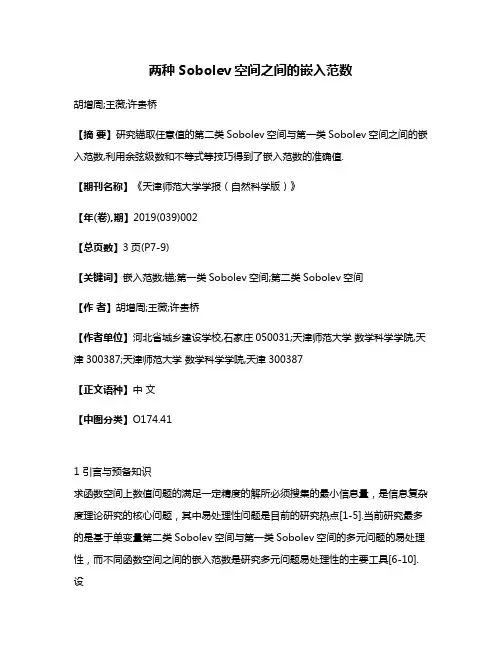
两种Sobolev空间之间的嵌入范数胡增周;王薇;许贵桥【摘要】研究锚取任意值的第二类Sobolev空间与第一类Sobolev空间之间的嵌入范数,利用余弦级数和不等式等技巧得到了嵌入范数的准确值.【期刊名称】《天津师范大学学报(自然科学版)》【年(卷),期】2019(039)002【总页数】3页(P7-9)【关键词】嵌入范数;锚;第一类Sobolev空间;第二类Sobolev空间【作者】胡增周;王薇;许贵桥【作者单位】河北省城乡建设学校,石家庄050031;天津师范大学数学科学学院,天津300387;天津师范大学数学科学学院,天津300387【正文语种】中文【中图分类】O174.411 引言与预备知识求函数空间上数值问题的满足一定精度的解所必须搜集的最小信息量,是信息复杂度理论研究的核心问题,其中易处理性问题是目前的研究热点[1-5].当前研究最多的是基于单变量第二类Sobolev空间与第一类Sobolev空间的多元问题的易处理性,而不同函数空间之间的嵌入范数是研究多元问题易处理性的主要工具[6-10].设且f是局部绝对连续的.在W21([0,1])上引入第一类Sobolev空间H1,其相应的范数为同时,在W21([0,1])上引入第二类Sobolev空间H2,其相应的范数为H2称为以c∈[0,1]为锚的Sobolev空间,其中c称为锚.显然,H1与H2之间是互相嵌入的,文献[8]对于锚取端点(即c=0)的H1与H2的嵌入范数做了研究,得到了嵌入范数的准确值,而在许多研究如文献[9,11-13]中,c的值都是任意的,本文对任意c∈[0,1],得到了嵌入范数的准确值.2 主要结论首先引入2种空间之间嵌入的定义.记下面引入算子范数的定义.设F、G为2个线性赋范空间,若算子I:F→G为一个线性有界算子,则线性算子I的范数为定理设I1、I2定义如式(1)和式(2),则其中∈[0,1].证明先计算‖I1‖H1→H2.记F=W21([0,1]).由定义知对f(x)做余弦展开得若,则由Parseval等式可得由此可得由式(3)和式(4)得因此有若的情况,此时有由式(3)和式(6)以及Cauchy-Schwarz不等式可得另外,令则ak满足且有下面计算将f(x)=(x-1)2在(0,1)上展开成余弦级数,有令x=2c,则有将式(10)代入式(9)得由式(7)、式(8)和式(11)可得对固定的a0,记其为a,则有因此令对g(a)关于a求导,可得g(a)当a=时取得最大值,且其最大值为下面计算其中c∈[0,1].如果则f′(x)几乎处处为0,即f(x)=a,a为常数,则显然有如果情况即对式(14)两边同时积分得由Fubini积分交换定理得由Cauchy-Schwarz不等式可得由式(16)和式(17)可得此外,令则f(x)同时满足由此结合式(18)可得由式(19)得由式(12)的计算过程可得注:当c=0时,由式(13)得文献[8]给出了上面的等式成立,但没有给出具体的证明,本文证明了文献[8]的结论,并对任意c∈[0,1]给出了该嵌入范数的具体值.【相关文献】[1]许贵桥.单形积上的Sobolev类逼近问题的易处理性[J].数学学报,2017,60(4):605-618.XU G Q.Tractablility of approximation problems in Sobolev classes definied over products simplices[J].Acta Mathematica Sinica,2017,60(4):605-618(in Chinese).[2]BASU K.Quasi-Monte Carlo tractability of high diensional integration over products of simplices[J].Journal of Complexity,2015,31(6):817-834.[3]NOVAKE,WOZNIAKOWSKIH.Tractabilityof Multivariate Problems,VolumeⅠ:Linear Information[M].Zürich:European Mathematical Society,2008.[4]NOVAK E,WOZNIAKOWSKI H.Tractability of Multivariate Problems,VolumeⅡ:Standard Information for Functionals[M].Zürich:European Mathematical Society,2010.[5]NOVAK E,WONIAKOWSKI H.Tractability of Multivariate Problems,VolumeⅢ:Standard Information for Operator[M].Zürich:European Mathematical Society,2012.[6]WASILKOWSKI G W.Tractability of approximation of ∞-variate functions with bouded mixed partial derivatives[J].Journal of Complexity 2014,30(3):325-346.[7]MICHAEL G,SEBASTIAN M,KLAUS R.On weighted Hilbert spaces and integration offunctions of infinitely many variables[J].Journal of Complexity,2014,30(2):29-47. [8]KRITZER P,PILLICHSHAMMER P,WASILKOWSKI G W.Very low truncation dimension for high dimensional integration under modest error demand[J].Journal of Complexity,2016,35(4):63-85.[9]GNEWUCH M,HEFTER M,HINRICHS A,et al.Equivalence of weighted anchored and ANOVA spaces of functions with mixed smoothness of order one in Lp[J].Journal of Complexity,2017,40(3):78-99.[10]WASILKOWSKI G W.On tractability of linear tensor product problems for ∞-variate classes of functions[J].Journal of Complexity,2013,29(5):351-369.[11]DICK J,KUO F Y,SLOAN I H.Acta Numerica:High Dimensional Integration:The Quasi-Monte Carlo Way[M].Cambridge:Cambridge University Press,2014.[12]HEFTER M,RITTER K,WASILKOWSKI G W.On equivalence of weighted anchored and ANOVA spaces of functions with mixed smoothness of order one in L1 or Lp[J].Journal of Complexity,2016,32(1):1-19.[13]GRICHBEL M,OSWALD P.Stable splittings of Hilbert spaces of functions of infinitely many variables[J].Journal of Complexity,2017,41(4):126-151.。
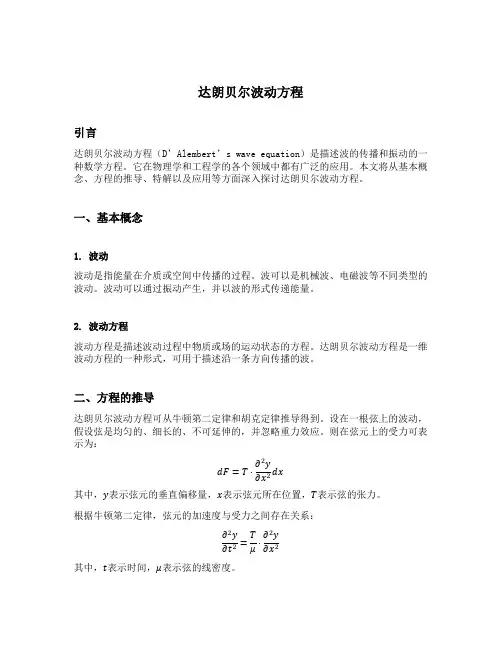
达朗贝尔波动方程引言达朗贝尔波动方程(D’Alembert’s wave equation)是描述波的传播和振动的一种数学方程。
它在物理学和工程学的各个领域中都有广泛的应用。
本文将从基本概念、方程的推导、特解以及应用等方面深入探讨达朗贝尔波动方程。
一、基本概念1. 波动波动是指能量在介质或空间中传播的过程。
波可以是机械波、电磁波等不同类型的波动。
波动可以通过振动产生,并以波的形式传递能量。
2. 波动方程波动方程是描述波动过程中物质或场的运动状态的方程。
达朗贝尔波动方程是一维波动方程的一种形式,可用于描述沿一条方向传播的波。
二、方程的推导达朗贝尔波动方程可从牛顿第二定律和胡克定律推导得到。
设在一根弦上的波动,假设弦是均匀的、细长的、不可延伸的,并忽略重力效应。
则在弦元上的受力可表示为:dF=T⋅∂2y ∂x2dx其中,y表示弦元的垂直偏移量,x表示弦元所在位置,T表示弦的张力。
根据牛顿第二定律,弦元的加速度与受力之间存在关系:∂2y ∂t2=Tμ⋅∂2y∂x2其中,t表示时间,μ表示弦的线密度。
由于波沿弦方向传播,假设波的传播速度为v,即:v=dx dt将上述关系带入方程中,得到达朗贝尔波动方程:∂2y ∂t2=v2⋅∂2y∂x2三、特解1. 没有边界当弦的两端没有固定边界时,方程的特解可表示为:y=f(x±vt)其中,f表示初始的波形,正负号分别表示波向左或向右传播。
2. 有边界当弦的两端有固定边界时,方程的特解可表示为:y(x,t)=R(x−vt)+S(x+vt)其中,R和S分别表示左右边界处波的反射情况。
四、应用达朗贝尔波动方程在各个领域都有广泛的应用,如声学、电磁学等。
下面以声学为例,介绍其应用。
1. 空气中的声波传播空气中的声波传播可以用达朗贝尔波动方程进行描述。
如果在一个封闭空间中有声源产生声波,声波将通过空气传播,并在封闭空间的各个位置上引起压强的变化。
通过解达朗贝尔波动方程,可以得到声波在空气中的传播速度、频率和波长等参数。
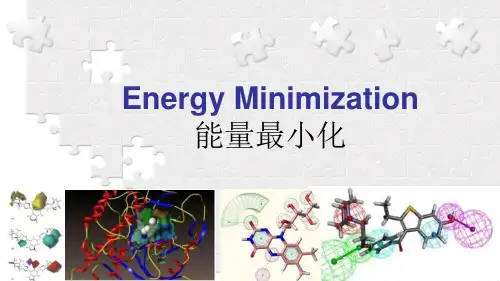

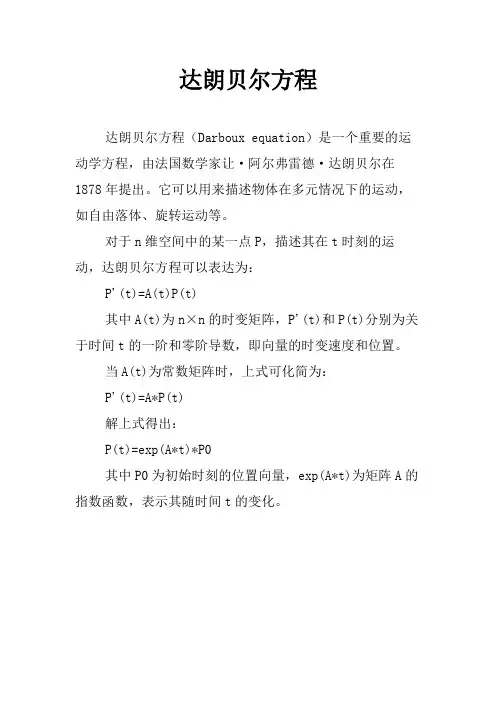
达朗贝尔方程
达朗贝尔方程(Darboux equation)是一个重要的运动学方程,由法国数学家让·阿尔弗雷德·达朗贝尔在1878年提出。
它可以用来描述物体在多元情况下的运动,如自由落体、旋转运动等。
对于n维空间中的某一点P,描述其在t时刻的运动,达朗贝尔方程可以表达为:
P'(t)=A(t)P(t)
其中A(t)为n×n的时变矩阵,P'(t)和P(t)分别为关于时间t的一阶和零阶导数,即向量的时变速度和位置。
当A(t)为常数矩阵时,上式可化简为:
P'(t)=A*P(t)
解上式得出:
P(t)=exp(A*t)*P0
其中P0为初始时刻的位置向量,exp(A*t)为矩阵A的指数函数,表示其随时间t的变化。
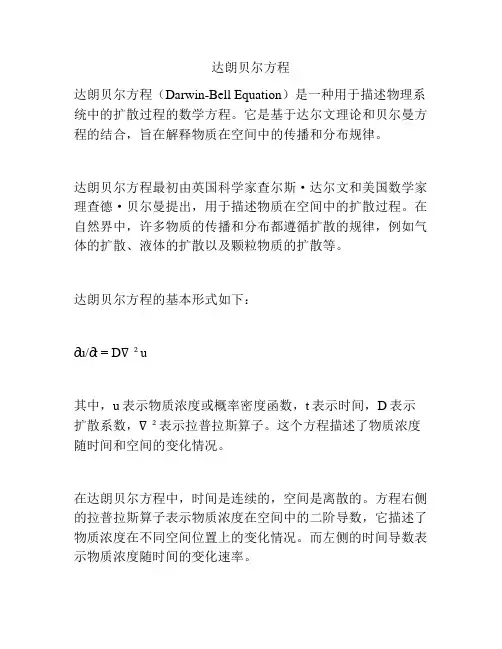
达朗贝尔方程达朗贝尔方程(Darwin-Bell Equation)是一种用于描述物理系统中的扩散过程的数学方程。
它是基于达尔文理论和贝尔曼方程的结合,旨在解释物质在空间中的传播和分布规律。
达朗贝尔方程最初由英国科学家查尔斯·达尔文和美国数学家理查德·贝尔曼提出,用于描述物质在空间中的扩散过程。
在自然界中,许多物质的传播和分布都遵循扩散的规律,例如气体的扩散、液体的扩散以及颗粒物质的扩散等。
达朗贝尔方程的基本形式如下:∂u/∂t = D∇²u其中,u表示物质浓度或概率密度函数,t表示时间,D表示扩散系数,∇²表示拉普拉斯算子。
这个方程描述了物质浓度随时间和空间的变化情况。
在达朗贝尔方程中,时间是连续的,空间是离散的。
方程右侧的拉普拉斯算子表示物质浓度在空间中的二阶导数,它描述了物质浓度在不同空间位置上的变化情况。
而左侧的时间导数表示物质浓度随时间的变化速率。
达朗贝尔方程可以用来解释许多现象,例如热传导、扩散现象以及物种在环境中的传播等。
通过求解达朗贝尔方程,可以得到物质浓度随时间和空间的变化规律,从而更好地理解和预测现象发生的过程。
在实际应用中,达朗贝尔方程被广泛应用于各个领域。
例如,在环境科学中,可以利用达朗贝尔方程研究污染物在大气、水体和土壤中的传播过程,从而指导环境保护和污染治理工作。
在生物学中,可以利用达朗贝尔方程研究物种在不同环境中的扩散和迁移规律,从而帮助保护生物多样性和生态平衡。
总之,达朗贝尔方程是一种描述扩散过程的数学方程,它可以帮助我们更好地理解和预测物质在空间中的传播和分布规律。
通过求解达朗贝尔方程,我们可以得到物质浓度随时间和空间的变化规律,从而为各个领域的应用提供科学依据和指导。
![常微分方程初值问题的预估-校正解法[文献综述]](https://uimg.taocdn.com/675ca1f28e9951e79b8927b6.webp)
毕业论文文献综述信息与计算科学常微分方程初值问题的预估-校正解法一、前言部分在生产实际和其他数学分支中,都会不断地遇到常微分方程,而在这些方程中,仅有很少的一部分能通过初等积分法给出通解或通积分,大多数积分必须数值计算。
所以,一开始就使用数值方法求解通常更有效]1[。
解常微分方程初值问题的数值方法通常可以分为两类]2[:(1)单步法,例如Euler方法和 Runge-Kutta方法;(2)多步法,例如线性多步法。
我们将同阶的显式公式与隐式公式相比,前者使用方便,计算量较小;而后者一般需用迭代法求解,计算量大,但其局部截断误差较小,稳定性较好。
两种方法各有长处和不足。
因此,常常将它们配合起来使用,以发挥它们的优点,弥补各自的不足]3[。
这样将显式公式和隐式公式联合使用,前者提供预测值,而后者将预测值加以校正,使数值解更精确。
由此形成的算法通常被称作预估-校正算法(简称为PC算法)原则上任一显式多步法和隐式多步法都可以搭配成预估校正算法及各种计算方案,但不是任一种方案都是可用的。
一个好的计算方案应该计算稳定,具有所需的精度,并且节约计算量]4[。
几种常见的预估-校正算法]5[:(1)Adams四阶预估-校正算法;(2)Milne方法(3)Hamming算法。
本文综述常微分初值问题的数值解法及其误差估计(相容性、稳定性和收敛性分析),重点介绍了预估-校正算法。
二、主题部分2.1 常微分方程的起源和发展]6[许多有关微分方程的教材都会提到发现海王星的故事。
海王星的发现是人类智慧的结晶,也是常微分方程巨大作用的体现,体现了数学演绎法的强大威力。
1781年发现天王星后,人们注意到它所在的位置总是和万有引力定律计算出来的结果不符。
于是有人怀疑万有引力定律的正确性;但也有人认为,这可能是受另外一颗尚未发现的行星吸引所致。
当时虽有不少人相信后一种假设,但缺乏去寻找这颗未知行星的办法和勇气。
23岁的英国剑桥大学的学生亚当斯承担了这项任务,他利用引力定律和对天王星的观测资料建立起微分方程,来求解和推算这颗未知行星的轨道。


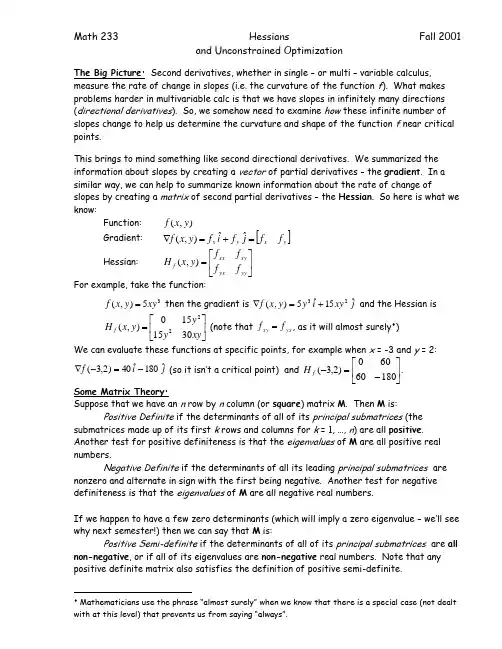
Math 233Hessians Fall 2001 and Unconstrained Optimization The Big Picture: Second derivatives, whether in single – or multi – variable calculus, measure the rate of change in slopes (i.e. the curvature of the function f ). What makes problems harder in multivariable calc is that we have slopes in infinitely many directions(directional derivatives ). So, we somehow need to examine how these infinite number of slopes change to help us determine the curvature and shape of the function f near critical points.This brings to mind something like second directional derivatives. We summarized the information about slopes by creating a vector of partial derivatives – the gradient . In a similar way, we can help to summarize known information about the rate of change ofslopes by creating a matrix of second partial derivatives – the Hessian . So here is what we know:Function: ),(y x fGradient:[]y x y x f f j f i f y x f =+=∇ˆˆ),(Hessian: ⎥⎦⎤⎢⎣⎡=yy yx xy xx f f f f f y x H ),( For example, take the function:35),(xy y x f = then the gradient is j xy i y y x f ˆ15ˆ5),(23+=∇ and the Hessian is⎥⎦⎤⎢⎣⎡=xy y y y x H f 3015150),(22 (note that yx xy f f =, as it will almost surely ♦) We can evaluate these functions at specific points, for example when x = -3 and y = 2:j i f ˆ180ˆ40)2,3(-=-∇ (so it isn’t a critical point) and ⎥⎦⎤⎢⎣⎡-=-18060600)2,3(f H . Some Matrix Theory:Suppose that we have an n row by n column (or square ) matrix M . Then M is:Positive Definite if the determinants of all of its principal submatrices (the submatrices made up of its first k rows and columns for k = 1, …, n ) are all positive . Another test for positive definiteness is that the eigenvalues of M are all positive real numbers.Negative Definite if the determinants of all its leading principal submatrices are nonzero and alternate in sign with the first being negative. Another test for negative definiteness is that the eigenvalues of M are all negative real numbers.If we happen to have a few zero determinants (which will imply a zero eigenvalue – we’ll see why next semester!) then we can say that M is:Positive Semi-definite if the determinants of all of its principal submatrices are all non-negative , or if all of its eigenvalues are non-negative real numbers. Note that any positive definite matrix also satisfies the definition of positive semi-definite.♦ Mathematicians use the phrase “almost surely” when we know that there is a special case (not dealt with at this level) that preven ts us from saying “always”.Negative Semi-definite if the determinants of all of its principal submatrices are alternate in sign, starting with a negative (with the allowance here of 0 determinants replacing one or more of the positive or negative values). A better test is to check if all of its eigenvalues are non-positive real numbers. Note that any negative definite matrix also satisfies the definition of negative semi-definite.Why we care:Let’s look at the function 23)5(3)4(40),(-+-+=y x x y x f , which has first partial derivatives )124(2-=x x f x and )5(6-=y f y , and the critical points (3, 5) and (0, 5).According to the test from the book, we would look at the “discriminant”: 2xy yy xx f f f - - which is exactly the determinant of the Hessian matrix!Let’s calculate the second partial derivatives: x x f xx 24122-=, 6=yy f , and 0=xy f . Thisgives us a Hessian matrix ⎥⎦⎤⎢⎣⎡-=6002412),(2x x y x H f . At the critical point (3, 5), here is the Hessian matrix: ⎥⎦⎤⎢⎣⎡=60036)5,3(f H . Note that the discriminant is (36)(6)-0 which is greater than 0. Thus we know we have a maximum or a minimum (we’ve only ruled out saddle point). If we think in terms of the matrix theory, at this point we can’t rule out Positive Def inite or Negative Definite (since both would have a determinant > 0 for the whole matrix). Looking at the sign of 036)5,3(>=xx f , so we see that we have a minimum. This is analogous to checking the sign of the first principalsubmatrix’s determi nant. Thus, all of the principal submatrices have positive determinants and the Hessian matrix is positive definite at the critical point (3,5).A Pause for some Theory:∙ The Hessian matrix is negative semi-definite at every unconstrained local maximumand positive semi-definite at every unconstrained local minimum.∙ A critical point of a function f is an unconstrained local maximum if the Hessianmatrix at the critical point is negative definite .∙ A critical point of a function f is an unconstrained local minimum if the Hessianmatrix at the critical point is positive definite .∙ A critical point of a function f is a saddle point if the Hessian matrix at the criticalpoint is neither positive semi-definite nor negative semi-definite .Back to our example:Let ’s look at the critical point (0, 5). Here is the Hessian matrix: ⎥⎦⎤⎢⎣⎡=6000)5,0(f H . Note that the discriminant is (0)(6)-0 which is equal to 0. Thus, according to the book, we are unable to classify the critical point. Using our new found powers, we can discriminate further. A quick check of the set of eigenvalues for this matrix yields {0, 6}. Thus, the Hessian matrix is positive semi-definite at the critical point (0, 5). Thus, we know that we cannot have a local maximum (since all local maxima have negative semi-definite Hessians). So we know we have either a local minimum or a saddle point.The Big Picture Again:So, no matter how many variables we have in our problem, all we have to do is determine whether the Hessian matrix is positive or negative definite at a critical point to exactly classify the critical point as a maximum or minimum.If we are lucky enough to have the Hessian matrix be positive semi-definite or negative semi-definite for all points (not just the critical point we are looking at), then we even know that we have a global maximum or minimum.Another Tangent in to the Realm of Mathworld♥…If the Hessian matrix H(x) is positive semi-definite at all x in its domain, then the function f(x) is convex. If a function is convex, then any critical points will be global minima (if there are multiple critical points, they will all have the same function value).If the Hessian matrix H(x) is negative semi-definite at all x in its domain, then the function f(x) is concave. If a function is concave, then any critical points will be global maxima (if there are multiple critical points, they will all have the same function value). The ties between positive/negative semi-definiteness and convexity/concavity are actually stronger than I stated them above – they are equivalent statements (i.e. you could reverse the if and then parts of the sentences).♥Only for the few souls that wish to journey into the mathematical land of functional theory…。

duhamel原理Duhamel原理是一种在工程数学中常用的方法,它可以用来解决线性常微分方程的初值问题。
这个原理的提出者是法国数学家Jean-Marie Constant Duhamel,他在19世纪初首次提出了这个方法,并且在实际工程问题中得到了广泛的应用。
在实际工程中,我们经常会遇到一些复杂的线性常微分方程,这些方程描述了许多物理现象,比如振动、传热、电路等等。
而这些方程往往很难直接求解,特别是在考虑到初值问题的情况下。
这时,Duhamel原理就可以派上用场了。
Duhamel原理的核心思想是将一个初值问题转化为一系列简单的初值问题的叠加。
具体来说,对于一个线性常微分方程。
\[ \frac{d}{dt}x(t) + Ax(t) = f(t) \]其中\(x(t)\)是未知函数,\(A\)是一个已知矩阵,\(f(t)\)是已知函数。
如果我们知道了初始条件\(x(0) = x_0\),那么我们可以通过Duhamel原理求解这个问题。
根据Duhamel原理,方程的解可以表示为。
\[ x(t) = e^{At}x_0 + \int_{0}^{t} e^{A(t-s)}f(s)ds \]这里,\(e^{At}\)是矩阵指数,它可以通过泰勒级数展开来计算。
而上式中的积分部分可以看作是对于外力\(f(t)\)作用的响应。
通过这种方式,我们可以将原始的初值问题转化为一系列简单的初值问题的叠加,然后分别求解这些简单的问题,最终得到原始问题的解。
Duhamel原理的应用非常广泛,特别是在振动、传热、电路等领域。
在这些领域,我们经常会遇到受到外部激励的线性系统,而Duhamel原理可以帮助我们求解这些系统的响应。
比如在机械振动问题中,我们可以利用Duhamel原理来求解系统的响应,从而分析系统的稳定性和性能;在传热问题中,我们可以利用Duhamel原理来研究材料的温度分布和传热特性;在电路问题中,我们可以利用Duhamel原理来分析电路的响应和稳定性。
常微分方程第三版答案4.3【篇一:常微分方程4】>[教学目标]1. 理解高阶线性微分方程的一般理论,n阶齐次(非齐次)线性微分方程解的性质与结构,熟练掌握n阶常系数齐次线性微分方程的待定指数函数解法。
2. 掌握n阶非齐次线性微分方程的常数变易法,理解n阶常系数非齐次线性微分方程特解的待定系数法和laplce变换法。
3. 熟练欧拉方程与高阶方程的降阶法和幂级数解法。
4. 掌握高阶方程的应用。
[教学重难点] 重点是线性微分方程解的性质与结构,高阶方程的各种解法。
难点是待定系数法求特解。
[教学方法] 讲授,实践。
[教学时间] 16学时[教学内容] 线性微分方程的一般理论,齐次(非齐次)线性微分方程解的性质与结构,非齐次线性微分方程的常数变量易法;常系数线性方程与欧拉方程的解法,非齐线性方程的比较系数法与拉氏变换法;高阶方程的降阶法和幂级数解法及高阶方程的应用。
[考核目标]1.理解高阶线性微分方程的一般理论,能够求解高阶常系数线性微分方程。
2.掌握n阶非齐次线性微分方程的常数变易法。
3.n阶常系数非齐次线性微分方程特解的待定系数法和laplce变换法。
4.熟练高阶方程的降阶法和幂级数解法及高阶方程的应用。
4.1线性微分方程的一般理论4.1.1引言讨论n阶线性微分方程dxdtnn?a1(t)dn?1xdtn?1???an?1(t)dxdt?an(t)x?f(t)(4.1)其中ai(t)(i?1,2,?,n)及f(t)都是区间a?t?b上的连续函数如果f(t)?0,则方程(4.1)变为:dxdtnn?a1(t)dn?1xdtn?1???an?1(t)dxdt?an(t)x?0(4.2)称它为n阶齐线性微分方程,而称一般的方程(4.1)为n阶非齐线性微分方程,并且通常把方程(4.2)叫对应于方程(4.1)的齐线性方程。
,,n及)f(t)都是区间a?t?b上的连续函数,则对于任一t0??a,b? 定理1 如果ai(t)(i?1,2?x0,x0,?,x0(1)(n?1),方程(4.1)存在唯一解x??(t),定义于区间a?t?b上,且满足初始条件:d?(t0)dtdn?1?(t0)?x0,?x(1),?,?(t0)n?1dt?x0n?((4.3)1)从这个定理可以看出,初始条件唯一地确定了方程(4.1)的解,而且这个解在所有ai(t)(i?1,2,?,n)及f(t)连续的整个区间a?t?b上有定义。
arXiv:0709.3968v3 [hep-th] 7 Jan 2008PreprinttypesetinJHEPstyle-HYPERVERSIONNeilBarnabyCanadianInstituteforTheoreticalAstrophysics,UniversityofToronto,60St.GeorgeSt.Toronto,OntarioM5S3H8CanadaEmail:barnaby@cita.utoronto.ca
NikyKamranDepartmentofMathematicsandStatistics,McGillUniversity,Montr´eal,Qu´ebec,H3A2K6CanadaEmail:nkamran@math.mcgill.ca
Abstract:Differentialequationsofinfiniteorderareanincreasinglyimportantclassofequationsintheoreticalphysics.Suchequationsareubiquitousinstringfieldtheoryandhaverecentlyattractedconsiderableinterestalsofromcosmologists.Thoughtheseequa-tionshavebeenstudiedintheclassicalmathematicalliterature,itappearsthatthephysicscommunityislargelyunawareoftherelevantformalism.Ofparticularimportanceisthefateoftheinitialvalueproblem.Underwhatcircumstancesdoinfiniteorderdifferen-tialequationspossessawell-definedinitialvalueproblemandhowmanyinitialdataarerequired?Inthispaperwestudytheinitialvalueproblemforinfiniteorderdifferentialequationsinthemathematicalframeworkoftheformaloperatorcalculus,withanalyticinitialdata.Thisformalismallowsustohandlesimultaneouslyawidearrayofdifferentnonlocalequationswithinasingleframeworkandalsoadmitsatransparentphysicalin-terpretation.Weshowthatdifferentialequationsofinfiniteorderdonotgenericallyadmitinfinitelymanyinitialdata.Rather,eachpoleofthepropagatorcontributestwoinitialdatatothefinalsolution.Thoughitispossibletofinddifferentialequationsofinfiniteorderwhichadmitwell-definedinitialvalueproblemwithonlytwoinitialdata,neitherthedynamicalequationsofp-adicstringtheorynorstringfieldtheoryseemtobelongtothisclass.However,boththeoriescanberenderedghost-freebysuitabledefinitionoftheactionoftheformalpseudo-differentialoperator.Thisprescriptionrestrictsthetheorytofrequencieswithinsomecontourinthecomplexplaneandhencemaybethoughtofasasortofultra-violetcut-off.Ourresultsplacecertainrecentattemptstostudyinflationinthecontextofnonlocalfieldtheoriesonamuchfirmermathematicalfooting.
Keywords:differentialequationsofinfiniteorder,stringfieldtheory,p-adicstrings,cosmologyoftheoriesbeyondtheSM.–1–1.Introduction1.1DifferentialEquationsofInfiniteOrderinTheoreticalPhysicsDifferentialequationscontaininganinfinitenumberofderivatives(bothtimeandspacederivatives)areanincreasinglyimportantclassofequationsintheoreticalphysics.Nonlocalfieldtheorieswithinfinitelymanypowersofthed’Alembertianoperator2(givenby2=−∂2t+∇2inflatspace)appearubiquitousinstringfieldtheories[1]-[10](forareviewsee[11]).Thisnonlocalstructureisalsosharedbyp-adicstringtheory[12](seealso[13]),atoymodelofthebosonicstringtachyon.Yetanotherexampleofafieldtheorycontaininginfinitelymanypowersof2canbeobtainedbyquantizingstringsonarandomlattice[14](seealso[15]).Moreover,fieldtheoriescontaininginfinitelymanyderivativeshaverecentlyreceivedconsiderableattentionfromcosmologists[16]-[34]duetoawidearrayofnovelcosmologicalpropertiesincludingthepossibilityofrealizingquintessencewithw<−1withinasensiblemicroscopictheory[16]-[21],improvedultra-violet(UV)behaviour[22,23],bouncingsolutions[22]-[24]andself-inflation[25](seealso[30]forapplicationsbothtobouncingcosmologiesandalsotodarkenergyandsee[29,31]foradiscussionoftheconstructionofcosmologicalsolutionsininfiniteordertheories).In[32]itwasshownthatcosmologicalmodelsbasedonp-adicstringtheorycangiverisetoslowrollinflationevenwhenthepotentialisextremelysteep.Thisremarkablebehaviourwasfoundtobearathergeneralfeatureofnonlocalhill-topinflationarymodelsin[33].In[34]itwasshownthatnonlocalhill-topinflationisamongtheveryfewclassesofinflationarymodelswhichcangiverisetoalargenongaussiansignatureintheCosmicMicrowaveBackground(CMB).Differentialequationswithinfinitelymanyderivativeswhicharisefrequentlyintheliteratureincludethedynamicalequationofp-adicstringtheory[12]
p−2/2φ=φp(1.1)wherepisaprimenumber(thoughitappearsthatthetheorycanbesensiblycontinuedtoothervaluesofpalso[35])andwehavesetms≡1.Asecondpopularexampleisthedynamicalequationofthetachyonfieldinbosonicopenstringfieldtheory(SFT)whichcanbecastintheform(see,forexample,[36])(1+2)e−c2−2φ=φ2(1.2)
wherec=ln(33/42).InbothcasesthefieldφisatachyonrepresentingtheinstabilityofsomenonBPSD-braneconfiguration.Moregenerally,thereisconsiderableinterestinapplicationsofawideclassofequationsoftheform[24,26,27,28]
F(2)φ=U(φ)(1.3)whereU(φ)=V′(φ)isthederivativeofsomepotentialenergyfunctionV(φ)associatedwiththefieldφandwerefertoF(z)asthekineticfunction.Equationsoftheform(1.3)areinterestingintheirownrightfromthemathematicalperspectiveandsomespecialcaseshavereceivedattentionrecently[37]-[40].